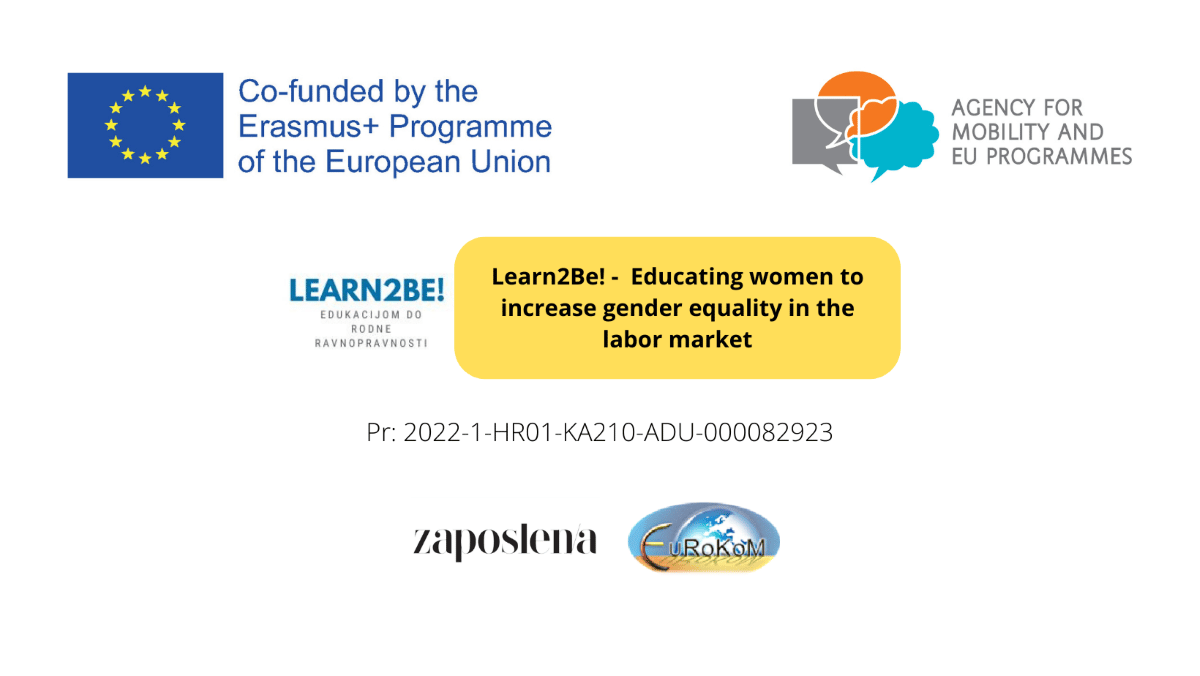
Program stjecanja kompetencija o rodnoj ravnopravnosti na tržištu rada – engleski jezik
Program stjecanja kompetencija o rodnoj ravnopravnosti na tržištu rada ima za cilj jačanje kompetencija o rodnoj ravnopravnosti na tržištu rada, a u nastavku ga donosimo na engleskom jeziku. Njegova namjera je razvoj znanja i vještina kojima će se polaznici, posebice žene, osnažiti u području rodne ravnopravnosti na tržištu rada kako bile radno konkurentnije i spremnije na izazove tržište rada.
1. Introduction
This program aims to strengthen competencies related to gender equality in the labour market. The intention is to develop the knowledge and skills that will empower trainees, women in particular, in the field of gender equality in the labour market in order to be more competitive and prepared for the challenges of the labour market.
The program was created as part of the Erasmus+ project Learn to be! – educating women to increase gender equality in the labour market, project leader ZAPOSLENA, izdavaštvo i marketing d.o.o. The aim of the project is to increase the equality and work competitiveness of unemployed women and women changing their careers by providing them with new knowledge and skills related to gender equality in the labour market. Gender equality is one of the main principles of the European Union that has not yet been achieved in practice. At EU level, an increasing number of women in the labour market and progress in ensuring better education and training for women are hopeful trends, but there are still gaps and discrimination based on gender and labour market conditions.
The project partner is Associazione Eurokom, a non-profit local development agency from Italy.
1.1 Justification for the adoption of the program
The program is based on an analysis of secondary sources that include existing literature, experiences of partner organizations in the field of adult education, promotion of gender equality, with an emphasis on the business context and training of women in their profession and monitoring of the gender equality parameter. According to the analysis, there is a need to improve knowledge based on new findings in the field of gender equality and the demands of the modern labour market, and to obtain tools to empower and motivate participants, women in particular. A need has been identified to improve and enhance the principles and methods of working with women in the field of gender equality in the labour market. This includes gender-based stereotypes in the labour market, a gender-equal economy, the digital transition and its importance, the elimination of gender-based differences in the labour market, a gender-sensitive environment and women’s rights in the labour market, as well as examples of good practice.
According to the analysis, which was carried out as part of the project preparation, it was found that adult women have a need for knowledge and skills on gender (non-)equality in the labour market, because it was shown that as many as 50 out of 58 women surveyed do not have sufficient knowledge on this topic. More recent EC data highlight that only 67% of women are employed, while 78% of men are employed, women in the EU earn 16% less per hour on average than men, and, on average, women have lower pensions than men by 30.1%. In addition, when surveying organizations dealing with adult women’s education, it was found that out of 70 adult education institutions included in the analysis and 10 organizations from the field of gender equality work, none educate women on this topic.
The program includes the development of digital competences in the context of gender equality. New Yields of Employment (NYE) and Information and Communication Technology (ICT) competencies are key today as the world and the labour market continue to evolve and change. The last Global Gender Gap Report prepared by the World Economic Forum in 2021 showed that women remain underrepresented in most of the so-called “Jobs of Tomorrow”, i.e. in areas such as Cloud Computing or Artificial Intelligence. It is therefore necessary to help women learn these new competences to counter gender inequality in the labour market. Very often people, especially the unemployed, cannot keep up with the rapid changes in society, the labour market and the economy in general. As a result, they lack much information on their opportunities and new tendencies in society, for example, the increased importance of ICT and the new skills needed to enter jobs in the framework of recent studies. As far as emerging new sectors are concerned, ICT skills could help adult unemployed women find work. ICT skills help with the job search process and also help with teleworking. Most often, digital skills are associated with smart work, teleworking, customer service, training, accounting, translations, programming, architecture and others. Nowadays, computers, platforms and digital tools as well as communication skills are the main assets for such professions. ICT skills and communication skills are useful and needed in today’s labour market. Good language and communication skills can result in the positions of a journalist, editor, copywriter, translator, etc. It is useful to think outside the box about different ways to make money. For example, one can create a website, blog and earn advertisements on social media or sell services, products.
All the aforementioned jobs can be successfully performed remotely. The possibilities are endless, and it would be good to hear about all the different opportunities that acquiring ICT skills can bring. Perhaps through these examples, unemployed women can find their true calling or figure out how they can use their skills for work, while employed women can use them to improve their career or quality of life. To make it easier for women to acquire these new skills and to understand how they can benefit from them, they need to be informed about the new employment returns, the meaning, the emerging sectors where ICT skills are more important, and the possibilities of finding jobs in these sectors. This is why it is crucial to focus on these new skills and understand the importance of digital tools in today’s world, and to be aware of the employment opportunities of today. In order to facilitate the acquisition of these new skills and to understand how they can be useful, it is necessary to explain the new employment returns, which means the emerging sectors where ICT skills are more important, as well as the possibilities of finding jobs in these sectors. Women are often only aware of traditional occupations, and that is what is offered to them.
2. General Information
2.1 Program Name
PROGRAM FOR ACQUIRING COMPETENCES RELATED TO GENDER EQUALITY IN THE LABOUR MARKET
Program objectives:
● Acquiring competences related to gender equality in the labour market, for women in particular, in order to make them more competitive and more prepared to meet the challenges of the labour market
2.2 Program duration
Duration: 48 hours
The program includes hybrid teaching.
2.3 Competences
● Critically assess gender stereotypes in the labour market
● Assess the state of gender equality in different national labour markets
● Distinguish between digital transition, entrepreneurship and other areas with the aim of increasing women’s employment in the labour market
● Explain the minimum standards of equal advancement of women and men in the personal and professional fields
● Explain the use of social networks in the field of communication, marketing and personal promotion for business purposes
● Evaluate own barriers to job search, job progression and/or job creation
● Differentiate between different types and forms of good examples of gender equality
2.4 Completion of the program
Upon completion of the program, participants are issued with a certificate of participation in the program.
3. Description of the program
3.1 Program structure
The modules of the program improve the professional competences and work competitiveness of participants, women in particular, in the field of gender equality in the business context.
The program consists of 6 modules:
Module 1: Gender-based stereotypes in the labour market
a. Situation in the EU
b. Situation in Croatia (Italy)
c. Gender stereotypes
Module 2: A gender-equal economy
a. Eliminating gender gaps in the labour market
b. Strategic areas of increasing the employment of women
c. Balance of personal and work life
Module 3: Digital Transition and Why It Matters
a. Digital Transition and Gender Equality
b. The Digital Transition and Impact on the Economy
c. Digital tools in the field of communications
d. Digital social network
e. Online job search
f. Digital Recruitment Platform (Linkedin)
Module 4: Eliminating gender-based differences in the labour market
a. Differences in employment and wages by sex
b. Women’s paid and unpaid work
c. Self-employment
d. Eliminating labour market differences
Module 5: Gender-aware environment and the rights of women in the labour market
a. Breaking down gender stereotypes
b. Discrimination in the labour market
c. Preparing for the labour market
d. A fairer labour market for women
e. Organizations focusing on supporting and empowering women in the labour market
f. Mentorship
Module 6: Examples of Good Practice
a. Examples of good practice in the field of balance between private and professional
b. Examples of good practice in the field of entrepreneurship
c. Examples of good practice in education, innovation, culture and sport
3.2 Description of the module
3.2.1 Module 1: Gender-based stereotypes in the labour market
Topic
Situation in the EU
Contents
The notion of gender equality
EU policy guidelines on gender equality
Gender Equality Index
Share of women in the EU parliament compared to national parliaments: an example of the Republic of Croatia
Share of women in the EU Parliament compared to national parliaments: an example of IT
Share of employment and unemployment in the labour market in the EU by gender
Learning outcomes
Describe and recognize gender inequality
Name an EU policy on gender equality
Express what is the Gender Equality Index
Identify eight areas of the Gender Equality Index
Critically assess the percentages in the EU regarding the labour market
No of hours
2
Topic
Situation in Croatia (Italy)
Contents
Gender Equality Index in Croatia
Constitution of the Republic of Croatia
Gender Equality Act
International Regulations on Gender Equality
The importance of documents and regulating gender equality
Use of gender-aware language
Employment and unemployment of women and men in Croatia
Employment and unemployment rates of women and men in Italy
Learning outcomes
Explain the Gender Equality Index in Croatia
Differentiate the part of the Law on Gender Equality related to the labour market
Distinguish the part of the Constitution that protects women
Differentiate documents and their role in regulating gender equality
Distinguish between gender-aware language and non-gender-aware language
Critically assess percentages in Croatia related to women and men in the labour market
No of hours
2
Topic
Gender stereotypes
Contents
The emergence of stereotypes
Examples of gender stereotypes in the business environment
The notion and types of gender roles
The negative aspect of gender roles in society
The negative aspect of gender roles in the labour market
Gender roles today compared to before
Gender stereotypes in the labour market
Linking gender roles and stereotypes
Artificial intelligence and gender stereotypes
Learning outcomes
Explain the term stereotype
Differentiate between gender roles
Explain the source of gender roles
Explain the negative aspect of gender roles
Compare gender roles
Critically assess gender stereotypes in the labour market
No of hours
4
3.2.2 Gender-equal economy (8 hours)
Topic
Eliminating gender gaps in the labour market
Contents
Historical connotations of gender and sex
The relationship between gender and sex in the economy
Women’s participation in the labour market in the context of a positive impact on the economy
Areas of structurally underrepresented women in the labour market
Learning outcomes:
Distinguish between the terms gender and sex
Explain how women in the labour market have a positive impact on the economy
Distinguish structures of women less represented in the labour market
No of hours
2
Topic
Strategic areas of increasing the employment of women
Contents
The digital transition as an area of greater female employment
Employment of women in the ICT sector
Employment of women in the STEM sector
The digital transition as an area of greater female employment
Employment of women in the ICT sector
Employment of women in the STEM sector
Entrepreneurship as an area of gender equality
Ways and opportunities of financing women
Other areas for increasing women’s employment in the labour market
Learning outcomes
Explain the digital transition as an area of greater female employment
Entrepreneurship as an area of gender equality
Differentiate other areas for increasing women’s employment in the labour market
No of hours
4
Topic: Balance of personal and work life
Contents:
Basic aspects of an individual’s professional and business life
Basic determinants of an individual’s private life
Work-life Balance Directive
Minimum standards for the equal advancement of women and men in the personal and professional fields
Learning outcomes
Explain how the Directive contributes to work-life balance
Explain the minimum standards of equal advancement of women and men in the personal and professional fields
No of hours
2
3.2.3 Digital transition and why it is important (8 hours)
Topic
Digital Transition and Gender Equality
Contents
Digital Transition in the European Union
Digital transition in other countries
Statistics on digital transition and economic growth
Knowledge of the impact of the digital transition on the EU economy
The notion and characteristics of the digital transition
The digital transition as a response to future challenges
New skills needed in the labour market to manage the digital transition in the EU
Learning outcomes
Explain scenarios and the situation in the EU and in each country
Explain the impact of the digital transition on the EU economy
Explain the digital transition and new challenges for the future
Labour market and the digital transition
No of hours
1
Topic
The Digital Transition and Impact on the Economy
Contents
Significance of digital tools in work and job search
The role of the Internet in finding work
Digital tools for increasing career opportunities
EU policies and programs to support digital transactions
Learning outcomes
Be aware of digital tools and learn how to use them to improve quality of life and find work
Explain the use of the Internet to grow the economy and find work
Use digital tools to improve careers and reduce the gender gap
Use the European Green Deal and Digital Opportunities
No of hours
1
Topic
Digital tools in the field of communications
Contents
Artificial intelligence and cloud computing
Digital self-empowerment and digital awareness opportunities
Digital communication tools: strengths and weaknesses
Opportunities of social media for the economy and business
Learning outcomes
Explain artificial intelligence and cloud computing
Explain the use of the e-platform for training and job search
Distinguish between digital awareness and how to empower oneself
Use digital communication tools/platforms and social media channels
Use algorithms of social media channels such as Fb, YouTube, Twitter, LinkedIn
Differentiate opportunities of social media use for the economy and business
Distinguish hashtags used by prospective employers
No of hours
1
Topic
Digital social network
Contents
Social networks as tools for the economy and the labour market
Social networks in response to the challenges of the future
Learning outcomes
Explain the use of social networks in the field of communication, marketing and promotion
Use digital job tools
Use social networks and new challenges of the future
No of hours
2
Topic
Online job search
Contents
Recruitment websites
Learning outcomes: Explain websites dedicated to finding work or starting a business
Explain communication with potential employers
No of hours
1
Topic
Digital Recruitment Platform (Linkedin)
Contents: Contents of the digital CV
Digital profile in the function of finding employment
Digital letter in the function of finding employment
Opportunities of LinkedIN in finding employment
Learning outcomes
Explain it writing a digital job profile
Explain the presentation of a digital letter for finding employment
Use Linkedin and the digital platform for employment as opportunities for women
No of hours
1
3.2.4 Eliminating gender-based differences in the labour market (8 hours)
Topic
Differences in employment and wages by sex
Contents
What is the gender gap in employment?
Examples and figures by country
How this gap arises and where exactly it is visible
How does the gap in salaries and pensions arise?
Same or different jobs – fact-finding
Industries where the gender pay gap is greatest
Economic consequences of the gender pay gap
Learning outcomes
Describe “employment gender gaps”
Identify how the employment gap arises and where it is manifested
Declare percentages in the gap for Croatia (Italy) and the EU
Identify how pay gaps arise
Identify how pension gaps arise
Economic consequences of the gender pay gap
No of hours
2
Topic
Women’s paid and unpaid work
Contents
Paid and unpaid work
Improving the balance between work and private life
Division of tasks for unpaid work between men and women
Learning outcomes
Differentiate between unpaid and paid work
Explain the unequal division of household tasks (unpaid work)
Explain the equal division of unpaid (household) tasks
No of hours
2
Topic
Self-employment
Contents
Economic independence for women and why it matters
False offers for self-employment
The difference between entrepreneurship and self-employment
Obstacles for women in creating their own business
Link to stereotypes/roles
Learning outcomes
Provide arguments for the importance of economic independence for women
Recognize ‘false’ offers for self-employment
Distinguish between self-employment and entrepreneurship
Evaluate your own barriers to creating your own business
No of hours
2
Topic
Eliminating labour market differences
Contents
Gender differences in the labour market: myth or reality?
EU Strategies for Gender Equality
Mechanisms for the elimination of differences
Regulatory reforms
What can women do to eliminate differences on their own?
What can men do to eliminate differences?
Learning outcomes
Analyse and describe the labour market situation by gender
Explain the meaning of EU gender equality strategies
Differentiate between mechanisms to eliminate labour market differences
Recommend goals for women and for men
No of hours
2
3.2.5 A gender-aware environment and the rights of women in the labour market
Topic
Breaking down gender stereotypes
Contents
Examples of gender roles in society
Examples of gender roles in the labour market
Stereotypes in the business environment and their recognition
Job interview from a gender equality perspective
Inappropriate questions at job interviews
Contract negotiation and essential items
Learning outcomes
Explain examples of gender roles in your environment
Identify past encounters with stereotypes in the labour market
Anticipate stereotypes in your business environment
Identify questions that should not be answered in a job interview
Identify items in a contract that may be unfavourable
Contract negotiation and essential points
No of hours
1
Topic
Discrimination in the labour market
Contents
Discrimination in the labour market
Discrimination Act
Procedure for reporting discrimination in the labour market
Learning outcomes
Explain the part of the Discrimination Act relating to women
Recognize discrimination in the labour market
Use the procedure for reporting discrimination to the competent authorities
No of hours
1
Topic
Preparing for the labour market
Contents
Significance of the CV
Basic parts of the CV and parts that add value
Creating a CV
Preparation for the interview
Identifying personal virtues key to competitiveness in the labour market
Presentation of key qualities for a particular type of employer
Public speaking in context
Learning outcomes
Create a quality CV
Provide arguments for skills required for a specific job
Prepare for public speaking
No of hours
2
Topic
A fairer labour market for women
Contents
Quotas and gender equality
Introduction of quotas and gender equality
Introduction of quotas in political work
The notion of a just society
Key points for a fairer work environment
Learning outcomes
Explain quotas in the context of gender equality
Explain the introduction of quotas in politics
Explain the introduction of quotas in the business environment
Distinguish between a just and unjust work environment
No of hours
1
Topic
Organizations focusing on supporting and empowering women in the labour market
Contents
Characteristics of organizations dealing with gender equality
Modalities of functioning of organizations dealing with gender equality
Significance of organizations dealing with gender equality
Role of temporary employment agencies
Learning outcomes
Differentiate between organizations that can provide support
Identify agencies to contact for support and information
No of hours
1
Topic
Mentorship
Contents
The notion of mentorship and its characteristics
The importance of mentorship as a tool for empowering women in the labour market
Effects of mentorship
Ways to find mentors
Learning outcomes
Explain the notion and significance of mentorship
Explain the effects of mentorship
Use ways of finding mentors
No of hours
2
3.2.6 Examples of good practice (8 hours)
Topic
Examples of good practice in the field of balance between private and professional
Contents
The factual meaning of equal opportunities
The state of equal opportunities in practice
Comparison of the situation of equal opportunities between the Republic of Croatia and Italy
Implementation of the equal opportunities policy
Promoting a work-life balance
Reducing difficulties in reconciling professional and family life
Learning outcomes
Explain equal opportunities policies
Explain what it means to promote a work-life balance
No of hours
2
Topic
Examples of good practice in the field of entrepreneurship
Contents
Promoting the employment of women
Financial support for women in the economy: women entrepreneurs
Women’s employment incentive: populism?
Women’s employment incentive: a thoughtful policy?
Promoting women’s entrepreneurship through sustainable tourism
Learning outcomes
Explain financial support to women in the economy: women entrepreneurs
Assess the importance of promoting women’s entrepreneurship through sustainable tourism
No of hours
4
Topic
Examples of good practice in education, innovation, culture and sport
Contents
Promoting employment of both sexes in the field of education, cultural activities and sports
Promoting an even gender representation in innovation
Learning outcomes
Explain the importance of both sexes’ employment in education, cultural activities and sports
Assess the importance of promoting gender balance in innovation
No of hours
2
Foto: Unseen Studio / Unsplash

















